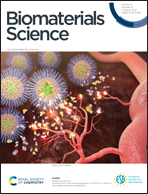A light and hypoxia-activated nanodrug for cascade photodynamic-chemo cancer therapy†
Abstract
Combination therapy provides significantly better outcomes than a single drug treatment and becomes an efficient strategy for cancer therapy at present. Owing to the advantages of improved drug bioavailability, decreased side effects, and drug codelivery properties, polymeric carrier-based nanodrugs show great application potential in combination therapy. In this study, a pH-responsive block polymer consisting of polyethylene glycol (mPEG) and poly(asparagyl diisopropylethylenediamine-co-phenylalanine) (P(Asp(DIP)-co-Phe)) is synthesized for drug delivery. The polymer self-assembles into nanovesicles and simultaneously encapsulates the hydrophilic hypoxia-activated prodrug tirapazamine (TPZ) and the hydrophobic photosensitizer dihydrogen porphin (chlorin e6, Ce6). The formed nanodrug can be triggered by near infrared irradiation to induce photodynamic therapy (PDT), resulting in a hypoxic tumor environment to activate the prodrug TPZ to achieve efficient chemotherapy. The cascade synergistic therapeutic effect is evaluated both in vitro and in vivo in a breast cancer mice model. This study reveals a potential strategy for efficient cancer therapy by using Ce6 and TPZ co-encapsulated nanovesicles.



 Please wait while we load your content...
Please wait while we load your content...